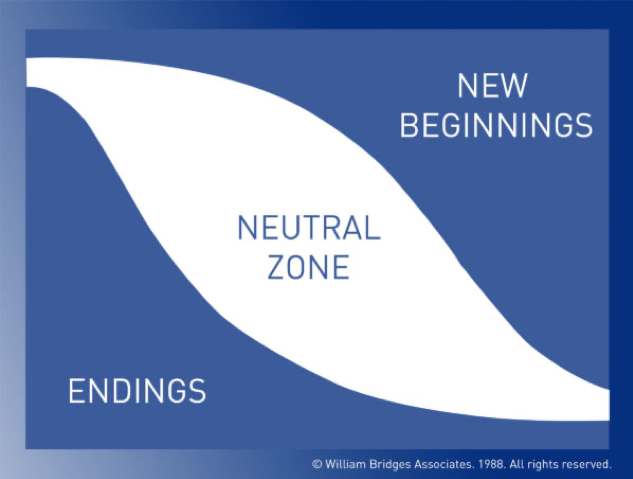Our governments are starting to share plans for reopening our economy and other aspects of our lives. This is welcome news as we wait in limbo for when work, home, family and social life can go back to some semblance of normal. It remains to be seen what changes may become more permanent, whether imposed or by choice.
Several weeks in now, looking back, we can begin to process the absolute tsunami of change we’ve been living through due to COVID-19, and start to plan for what’s still to come.
It’s been reminding me a lot of change management principles I’ve studied and taught, particularly William Bridges’ Transition Management model, published in his 1991 book “Managing Transitions.” This model focuses on the internal reactions people have to changes in their organization. It’s typically used in the context of M&A or project management, but it certainly applies to this situation we are going through in our organizations and otherwise in recent weeks.
The Bridges’ Transition Model identifies the 3 stages individuals experience during change: Ending What Currently Is, The Neutral Zone and The New Beginning.

This in-between phase we find ourselves in now would be called “The Neutral Zone” in the Bridges Transition model. It is a very uncomfortable place for some, and a favourite of others. I personally like it, so I wanted to shed some light on it and share some strategies to help you get through it, whether you’re managing yourself or others.
What is the difference between change and transition?
Change is an external event or situation that takes place: a new business strategy, new leadership, a merger, a new product. In this case, a pandemic and its resulting fallout… Change can happen very quickly. Many people are uncomfortable with change, for all sorts of reasons, which can lead them to resist it. Empathetic leaders recognize that change can put people in crisis, and help guide them through it.
Transition is the psychological process that people go through as they accept and come to terms with the change or new situation, and can take a much longer time. Change can be more successful if leaders and organizations acknowledge the transition that people experience, and support them through it. This is key to capitalizing on opportunities for innovation, and creating organizational resilience.
Managing the stages of transition
Stage 1: Endings
This first phase of transition begins with an ending, when people identify what they are losing and learn how to manage these losses. They determine what is over and being left behind, and what they will keep. These may include relationships, processes, team members or locations. This stage may involve many emotions similar to grief, including fear, loss, denial, anger, sadness etc.
People often fear the unknown, so the more leaders listen, communication and educate staff about a positive future, and how their knowledge and skills are an essential part of getting there, the likelier they are to move on to the next stage. You may also offer support (e.g., training and resources) to help them work effectively in the new environment.
Stage 2: Neutral Zone
The second step of transition is an in-between time when the old is gone but the new isn’t fully operational, or perhaps even fully conceived yet. It is when the critical psychological realignments take place, between the old reality and sense of identity and the new one.
As this phase is the bridge between the old and the new, some people will still be attached to old roles and processes, while some are trying to figure out or adapt to the new. They are in flux and may feel some confusion and distress. Some may experience resentment, resistance, low morale, low productivity or anxiety about their role or status in the organization.
This stage can also be one of great creativity, innovation, and renewal. This is a great time to encourage people to try new ways of thinking or working. You may engage them to contribute ideas for how to improve internal processes, and even the products or services you provide.
Leadership and guidance is especially important as people go through this neutral period, as it is the foundation for new beginnings. It can seem unproductive and scary at times. Because people might feel a bit lost, provide them with a sense of direction. Remind them of team goals, and encourage them to talk about their ideas, challenges and what they’re feeling.
Other key leadership/management tactics for this stage include:
- Frequent touchpoints and feedback on performance, especially regarding the transition
- Setting short-term goals
- Celebrating quick wins, recognizing contributions and other steps to boost morale
- Help people manage their workloads, de-prioritizing some types of work, bringing in additional resources
Stage 3: New Beginnings
The last transition stage is the reward. People have begun to embrace the change. They’re building the skills they need to work successfully in the new way, and they’re starting to see early wins from their efforts. There is energy in a new direction – an expression of a fresh identity.
Well-managed transitions allow people to establish new roles with an understanding of their purpose, the part they play, and how to contribute and participate most effectively. As a result, they feel reoriented, renewed and committed to the organization and their role.
The transition management process
Bridges says that people will go through each stage at their own pace. Those who are comfortable with change are more likely to move ahead more quickly to stage 3, while others may linger at stages 1 or 2.
Successful transition management includes these steps:
- Communicating with the organization about the change coming and why.
- Collecting information from those affected to understand its impact on them, and gaining their investment in the outcome. (I would suggest getting them involved in the idea-generating process early on and ongoing – as they may have the best ideas and solutions that will aid in change implementation)
- Educating people leaders about how to manage staff during the transition effectively
- Helping staff understand how they can positively contribute to the change and the importance of their role in the organization.
- Celebrating success(es)
There may be occasional setbacks as you manage your transitions. Don’t get discouraged. Having a plan, with some fluidity to react to unforeseen circumstances, is probably the best approach to lead yourself, your business and teams through this unpredictable, yet manageable, future.
Feel free to contact me if I can assist in any way.
“The essence of life takes place in the neutral zone phase of transition. It is in that interim spaciousness that all possibilities, creativity and innovative ideas can come to life and flourish.” — Susan Bridges
Acknowledgements:
Managing Transitions by William Bridges, copyright [©] 1991, 2003, 2009, 2017. http://wmbridges.com/about/what-is-transition/
Besides the Bridges Transition site, I used Mind Tools to research this article and have used it in the past. Mind Tools is an affordable, subscription based, online management learning site with practical, bite-size resources and a free newsletter.
http://www.mindtools.com/pages/article/bridges-transition-model.htm
